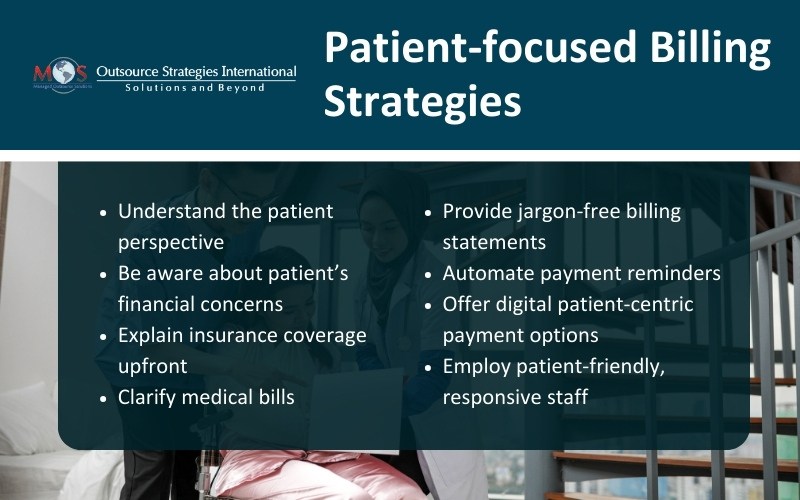Like value-based care, patient centricity is one of the top emerging trends in medical billing. Patient centricity, a quality measure put forward by the National Academy of Medicine, focuses on prioritizing the patient experience in healthcare delivery. However, one area that continues to cause confusion and frustration for patients is medical billing. This confusion can lead to stress and frustration, impacting recovery and well-being. Implementing patient-focused billing strategies can ensure a clear, concise and streamlined billing experience, improving patient satisfaction and trust in the healthcare system.


Enhance the patient experience and maximize revenue with our medical billing services!
Call Now (800) 670-2809
Strategies to Improve the Patient Experience in Billing
Improving the patient experience in billing involves simplifying the process and providing clarity and support at every step.
Understand Patient Perspectives and Concerns
The first step in enhancing your patients’ billing experience entails understanding their perspective. Intricate codes, complex terminology, and varied insurance processes create a maze that many find difficult to navigate. Understanding the costs, interpreting invoices, and comprehending what is covered by insurance versus what needs to be paid out-of-pocket makes things even more challenging.
As a healthcare provider, you need to understand what makes patients anxious about medical bills. A survey conducted by Copatient found that around 72% of American consumers are confused by their medical bills, and 94% of consumers have received medical bills they considered to be “too expensive”. One primary concern is the lack of clarity regarding costs. This usually includes uncertainty about what services are covered by insurance and what expenses will need to be paid out-of-pocket. Complex insurance terminology such as co-pays, deductibles, and Explanation of Benefit (EOB), insurance adjustments, and odd procedural codes can also be extremely confusing for patients.
Transparent Communication
Transparent communication is key patient-centric approach in modern billing. Your patients need to understand exactly what they are being billed for, and also any other potential financial responsibilities. To help them make sense of their medical bills, clarify charges and explain insurance coverage. Best practices include:
- Offering clear and comprehensible itemized invoices and statements.
- Explaining billing practices, costs and what services are covered by insurance.
- Clarifying insurance coverage upfront (including co-pays if applicable) and potential out-of-pocket expenses before providing treatment.
Providing clear, jargon-free billing statements can significantly help them comprehend their bills. By demystifying the billing process, patients can understand their financial obligations upfront, make informed decisions, and avoid unexpected financial burdens.
Another aspect of communication that patients are likely to appreciate is sending them reminders about their balances via text, email, or live chat. Automating payment reminders and notification scan help avoid missed payments or late fees. Make sure you communicate with patients using their preferred option.
Simplify the Payment Process with Tech
In addition to transparent communication on medical costs and financial responsibilities, it’s crucial to focus on simplifying the latter stages of the billing process by providing convenient and adaptable payment options. As our world progresses digitally, healthcare risks falling behind if practices don’t embrace new technologies. Digital patient-centric payment models make it easier to share billing information and receive electronic payments from patients.
Offering various payment options and flexible plans significantly alleviate the load of substantial medical bills.
- Digital payments streamline accessing billing details, aiding balance inquiries, and offering multiple payment choices.
- Implementing installment or extended payment plans eases immediate financial strain.
- Diverse payment methods like credit cards, online payments, or automatic deductions grant patients bill settlement flexibility.
- Point-of-service collections involve collecting patient payments at the time of service or immediately after, boosting transparency and minimizing billing surprises.
When implemented sensitively, these options enable patients to manage their medical expenses based on their financial circumstances, reducing stress and ensuring a smoother payment experience.
While automation has greatly improved the efficiency and accuracy of billing processes, there are still limitations to its capabilities. For example, when healthcare providers delegate their verification process to us, this enables them to inform patients about their complete responsibilities before their appointments. Additionally, the EMR/EHR automates claims, but we still need to thoroughly examine them before submission, as the automation often overlooks crucial elements such as modifiers necessary for claim payment.
The bottom line: human expertise is essential to handle complex cases, ensure compliance, detect errors, and provide personalized patient communication.
Knowledgeable Staff
To provide a patient-centric billing experience, your practice also needs to have well-informed staff capable of addressing patient inquiries effectively and who are empathetic and responsive to patient concerns. The American Medical Association (AMA) recommends providing your staff with prepared scripts to consistently communicate the practice’s payment policy at the time of service. Knowledgeable staff can help patients navigate complex billing systems, offering clear explanations, guidance, and assistance throughout the billing process.
These staff members understand the intricacies of medical charges, insurance coverage, and payment options, allowing them to provide personalized support tailored to each patient’s needs. They also aim to alleviate patient anxiety, answer questions promptly, and provide solutions for smoother and more patient-friendly billing experience. This can contribute significantly to building patients’ trust and satisfaction in billing matters.
A streamlined and satisfactory patient experience extends to your patients’ interactions with your practice before and after their treatments. It’s the key to building trust and relationships with patients in today’s competitive healthcare industry in the years to come. As healthcare continues to evolve, placing patients at the center of the billing process is crucial. Partnering with an experienced medical billing company can streamline the billing process for patients and your practice, enhancing patient satisfaction in healthcare billing and increasing practice revenue.


Ensure a smooth billing experience that prioritizes patient needs and satisfaction.
Call Now (800) 670-2809





